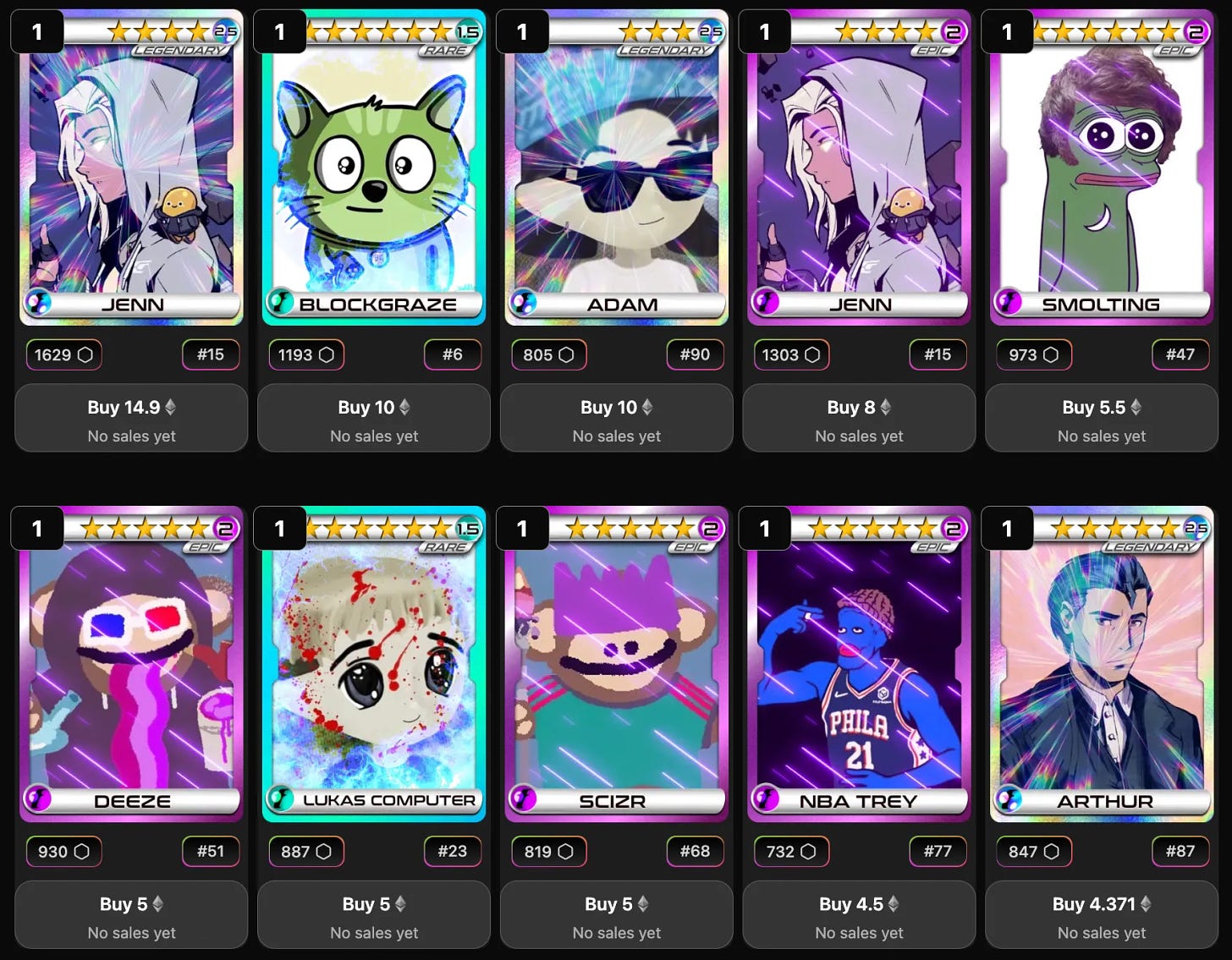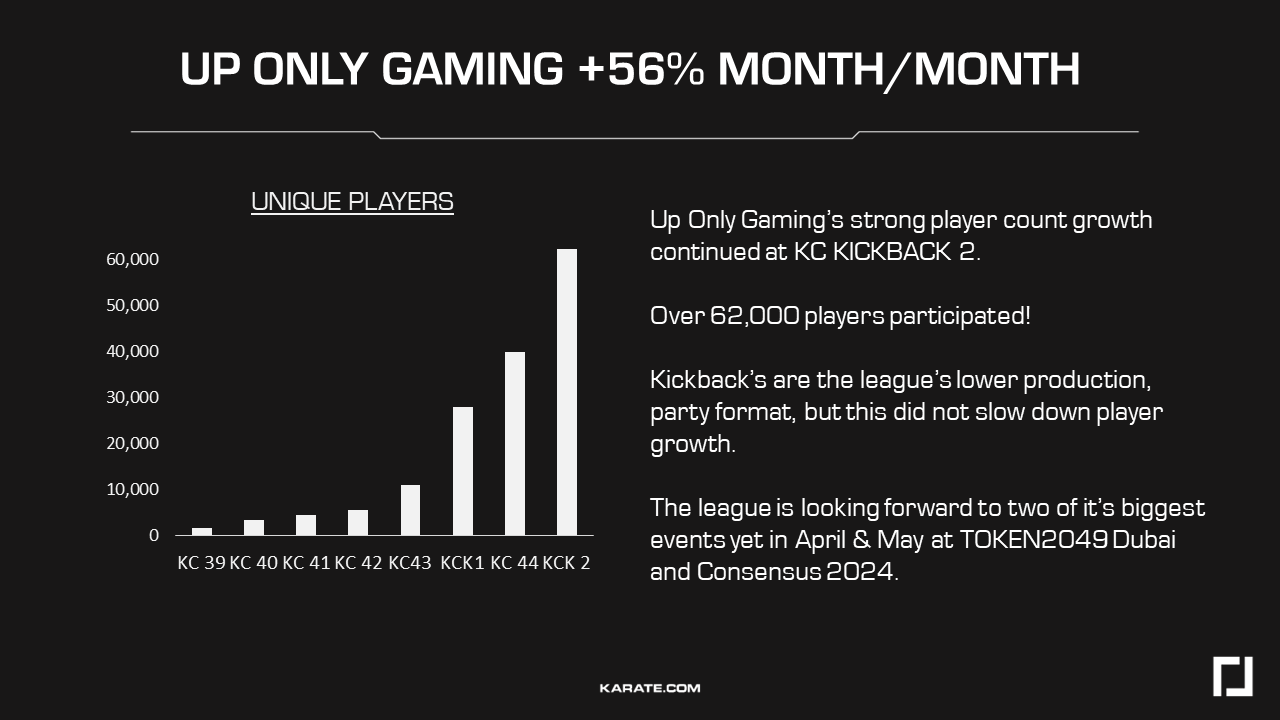Fantasy Top: The Crypto Fantasy Game

What if a Daily Fantasy Sports game was based on influencers rather than athletes? Fantasy Top has entered the chat…
If you’ve been living under a rock or have been on holiday recently, you may not have heard a great deal about Fantasy Top.
Fantasy Top is a game built around X activity (Formerly Twitter) and offers sizable rewards and incentives for players. The crypto industry’s most famous influencers and thought leaders have been turned into NFT playing cards, and the game runs on Blast a scaling network.
Discussed in this edition of Beinchain Sport:
- What is Fantasy Top? 🃏
a) Overview
b) Packs, Heroes and Scoring
c) Tournaments - The Sports of tomorrow = Weird? 🤔
- Analysis & Concluding Thoughts 🧠
a) Data breakdown: Volume, Sales & Users
b) Op-ed led analysis
What is Fantasy Top?
Fantasy Top is a Daily Fantasy Sports game. Traditionally, this is a model attached to real sports — where fans and punters draft a team of players and their real-life performance places them in rankings amongst their peers. Typically, there are payouts for the top percentile of players in these rankings and this format was first popularised in the US a decade or so ago as an alternative to traditional betting, which was banned and hamstrung by federal and state regulation.
This concept has been taken by Fantasy Top and applied to social accounts on X.
Rather than picking sportspeople for your lineups, you pick crypto influencer accounts on X.
Thought leaders, influencers and big anonymous crypto accounts on the social platform are called ‘Heroes’ on Fantasy Top.

Each of these Heroes are ownable as NFT cards, with each of them having a certain supply. Players are able to purchase these Heroes by buying packs which, like a pack of panini stickers, have randomised cards within them, or by buying cards using a secondary marketplace. Heroes are also winnable as prizes from tournaments. These Heroes are regularly updated, with new ones being added as frequently as once per week. Users draft a team of these heroes in what is called a ‘deck’ — which is your ‘5-aside’ team of heroes, which you can then enter a tournament to compete against other decks. All Heroes have a number of stars at the top which indicates their ‘form’, across a 7-day moving average of their score. Heroes also have rarity rankings; Common, Rare, Epic and Legendary. These rarities give users point multipliers in tournaments as follows: Common: 1x, Rare: 1.5x, Epic: 2x and Legendary: 2.5x. For example, if your Hero has a score of 800 and it’s Rare, it will have 1200 points overall with the multiplier.
The point-scoring system for Heroes playable in tournaments is based on their engagement on X, although the algorithm isn’t transparent. There are however apparently consistent updates to this algorithm, and there are mechanisms that prevent bigger social accounts from dominating point scoring.
Influencers must grant Fantasy Top permission to create Heroes using their name, and in return are granted a 1.5% royalty fee on every secondary market trade of their respective Hero NFT, and 2% of revenue from packs that have their heroes in them.
Many influencers who have signed up have seen sizable windfalls from this.
So what about tournaments?
The tournaments in Fantasy Top can have varying formats. Some may be open to all card types, some to Heroes with specific parameters — follower count on X for example.
To stop those with a large number of Heroes consistently dominating tournaments, there are also leagues — divisions split from 5 to 1. This means players are pooled to compete against other players of similar skill levels. The incentive to climb these divisions is better rewards, which can come in the form of cards (Heroes), packs, skins (aesthetic rewards), Ether (Ethereum), Blast Gold, or Fantasy Top’s two native currencies Fan Points and Stars.
The Sports of tomorrow = Weird?
A cliche you hear often from thought leaders in the sports industry is that sports are no longer competing with each other, but with tech and entertainment giants like TikTok and Netflix.
The attention economy.
Everyone has several hours a day dedicated to things outside of socialising with their friends & family, working, eating and sleeping.
Sports are actively competing for that sliver of time.
The likes of the NBA, NFL, EPL and established giants have a strong moat. They have the broadcast deals, the talent, the distribution and the fanbases — so how do you compete with that? For example, those who have tried to create a new American Football League in the US have struggled. And there are a lot of reasons why these greenfield, but similar-to-the-original sports leagues fail — but for the most part, they’re not bold enough.
Let’s take the Kings & Queens League, for example, founded by former Barcelona FC Legend Gerard Pique. Their holding company Kosmos just raised $65m. They claim it is the most-watched soccer league globally. It has more than 13 million followers on its digital platforms, with more than 82 million views on TikTok and more than 80 million hours of content watched. The rule-set, branding is built for the digital age. Fast-paced, highlight reels galore and storylines aplenty. It feels like Soccer, but it’s different.
Karate Combat are a more crypto-centric example. Imagine the UFC, but only striking, and rather than a cage, fighters are in a square pit with 45-degree walls on each side. The league in itself is governed by the $KARATE token and rules can be changed via votes, by token holders. The tokens can also be wagered in fights, in no-loss wagers, in their ‘Up-Only Gaming’ model.

Their results have been strong, seeing over 60,000 participants in their latest event. That’s a huge growth from under 3,000 in the first event this model was implemented.
Again, this looks and feels like a combat sport, but it’s built for the digital age. Gamified social experiences, wagering and ownership wrapped into a seamless user experience that most Gen-Z would expect from a social tech product.
Adjacently, over the past 5 years amateur sports have garnered huge attention — building up audiences through video and social. Amateur Sunday league soccer teams like Baiteze and SE Dons sell thousands of replica shirts and have branded sponsor deals. Famous YouTube influencers Sidemen had 37m views on their Sidemen Charity game for 2023.
This may all seem silly to most sports executives, but the stuff that starts looking like a fun toy often becomes the biggest disruptor.
Fantasy Top might not impact the sports industry now, but something like it might. Things that captivate sports fans have to be different, quirky and fun.
How do you make a sports product feel familiar but be radically different simultaneously?
Analysis & Concluding Thoughts
Fantasy Top only went live this month, in May 2024.
And the numbers are truly staggering.

As per CryptoSlam, Fantasy Top has had over $46m in sales this May 2024 so far, facilitating nearly 1 million transfers, and over 400,000 pack mints, with an average sale of ~$140.

The platform launched attracting over 15,000 users (as per flipside crypto) and has settled at between ~3,000 – 10,000 daily active users since.
The game is the ‘in’ thing in crypto right now, and when you’re the ‘in’ thing in crypto whilst the market is hot, you often see insane numbers. When things rocket so fast, however, you do tend to see cracks appear in the foundations.
As Bcheque writes in a recent edition of his newsletter:
Whilst the game has attracted huge mindshare and got people excited, there has been some trouble with botting: prominent creators have been “attacked” by bots, meaning their follower accounts have been increased rapidly, meaning their metrics are no longer trustworthy, which means the team had to downgrade their scores.
Having discussed greenfield sports products trying to break the status quo, it begs the question of where Fantasy Top sits in terms of target market.
Whereas DraftKings and Sorare have cornered the license sports market in NFT Fantasy, have Fantasy Top emerged as a pseudo-competitor?
Instead of athletes, it’s influencers.
Instead of licenses to teams and leagues, its on-chain revenue splits directly to the influencers.
Instead of pressure to meet minimum guarantees via primary sales, influencers are under pressure to generate buzz for their Hero card holders.
The overheads for Fantasy Top are low and they are currently printing money without even charging entry costs to tournaments, which is where traditional Daily Fantasy Sports products make most of their money.
But there are downsides, of course.
Firstly, this could be the flavour of the month in crypto and the sustainability of the model itself is questionable. Currently, 45% of revenue is going out to player payouts, which will need to decrease at scale, you’d think.
The part that worries me more, however, is the reliance on X.
Fantasy Top’s entire business model is based on a) everyone in crypto being on X in a big way and b) X being a big platform long-term. That’s probably a reasonable bet to make, but we’ve seen booms in decentralised social protocols like Farcaster recently, for example, start to take small but potentially meaningful market share.
Things can change quickly. Social Media is volatile and algorithms can change in a heartbeat. There are bot attacks. And X could randomly decide to ban Fantasy Top’s API, who knows? I foresee there being an issue here one way or another long term.
Nonetheless, the platform has got people in crypto excited. It’s a consumer-facing proposition by crypto people for crypto people, driving huge revenues with a quite sticky audience so far.
My opinion on ‘SocialFi’ (financialized social media) is that it’s not a thing in the sense that the future of social interactions digitally won’t be financialized. It’s dumb for a plethora of reasons that we can save for another newsletter. But where Fantasy Top have struck gold is having an easy signup flow using X, in-built distribution by making the biggest audience generators their ‘athletes’ in the fantasy game, and aligning incentives so that they want to play, engage and talk about Fantasy Top.
Where it goes from here, I’m not totally sure. But it is a bit of a eureka moment for the space from a gamification and consumer perspective.



